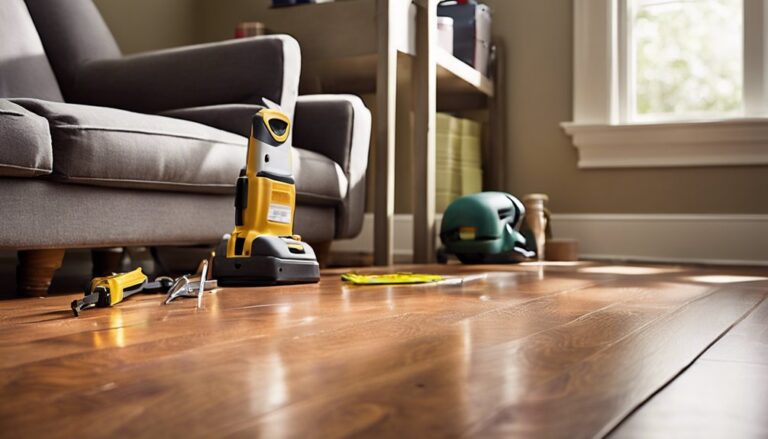To finish your basement floor, first inspect for moisture, cracks, and unevenness, then clean and prep the surface. Install a moisture barrier like polyethylene sheeting with sealed seams to prevent dampness. Choose durable, moisture-resistant flooring designed for basement use and lay it starting from the longest wall, maintaining expansion gaps. Finish with baseboards and seal edges for a polished look. Follow these steps properly, and you’ll guarantee durability and comfort—there’s more detail to optimize your project’s success.
Assessing Your Basement Floor Condition

Before you begin finishing your basement floor, it’s vital to thoroughly assess its current condition. Start with a detailed floor inspection checklist to identify cracks, moisture, or unevenness. Check for signs of foundation issues, such as shifting or settling, which could compromise your new floor’s integrity. Use a moisture meter to detect damp spots that may require sealing or waterproofing before installation. Measure the floor’s levelness with a laser level or straightedge to guarantee proper drainage and material adhesion. Address any debris, oil stains, or loose concrete fragments that could interfere with pavimentazione adhesives. This precise evaluation ensures you tackle potential problems early, providing you the freedom to choose and install your flooring without unexpected setbacks or costly repairs down the line.
Choosing the Right Flooring Material
When choosing basement flooring, you need to prioritize moisture resistance to prevent damage over time. Consider the durability and maintenance requirements of each material to guarantee long-term performance. Finally, balance aesthetics and comfort to create a space that’s both functional and inviting.
Moisture Resistance Options
Since basements are prone to moisture issues, selecting flooring materials that resist water infiltration is critical to preventing damage and mold growth. Effective moisture proofing and basement sealing work hand-in-hand with your flooring choice. Here’s a quick guide to materials optimized for moisture resistance:
| Materiale per pavimenti | Moisture Resistance Level |
|---|---|
| Vinyl Planks | Alto |
| Piastrelle di ceramica | Molto alto |
| Epoxy Coating | Molto alto |
| Legno ingegnerizzato | Moderare |
| Carpet (Moisture Barrier) | Low to Moderate |
Vinyl and ceramic tile excel in moisture proofing, while epoxy coatings offer a seamless, waterproof surface. Engineered wood needs careful basement sealing beneath it. Avoid carpet unless using specialized moisture barriers. Choosing the right material guarantees freedom from moisture woes and long-term floor integrity.
Durata e manutenzione
Although moisture resistance is essential, you’ll also need to take into account durability and maintenance when selecting basement flooring. Your choice should guarantee long term performance under potential heavy foot traffic and possible impacts. Materials like vinyl plank and ceramic tile offer robust surfaces resistant to scratches and dents, minimizing frequent repairs. Consider repair strategies upfront: opt for flooring that allows simple replacement of damaged sections rather than full removal. Avoid porous or delicate surfaces that require specialized upkeep, increasing maintenance time and cost. Also, evaluate how easily the flooring cleans—low-maintenance options free you from constant attention. Prioritizing these factors grants you freedom from ongoing issues and preserves the basement’s usability for years, making your investment practical and sustainable.
Aesthetics and Comfort
While durability and maintenance are critical, you shouldn’t overlook aesthetics and comfort when choosing basement flooring. Selecting the right material impacts your space’s feel and visual appeal, influencing how freely you enjoy the area. Focus on flooring that complements your desired color schemes, ensuring cohesion with walls and furnishings. Materials like luxury vinyl plank or engineered hardwood offer warmth and style, while ceramic tiles provide sleekness but may need area rugs for added comfort underfoot. Area rugs not only enhance softness but also introduce texture and color contrast, allowing flexibility in design without permanent commitment. Prioritize flooring options that balance your practical needs with the freedom to customize aesthetics, ensuring your basement feels inviting, comfortable, and aligned with your personal taste.
Preparing the Basement Floor Surface
Before you can install any flooring materials, you’ll need to thoroughly prepare the basement floor surface to guarantee proper adhesion and durability. Start with detailed surface preparation by inspecting the concrete for cracks, uneven areas, or debris. Use a wire brush or grinder to remove loose particles and roughen the surface if needed. Next, perform floor cleaning using a high-quality vacuum to eliminate dust, dirt, and residual contaminants. Follow up with a damp mop using a mild detergent to confirm the floor is free of oils or grease that could interfere with bonding. Allow the floor to dry completely before proceeding. Proper surface preparation sets the foundation for lasting results, giving you the freedom to choose flooring options without worry about long-term performance issues.
Installing a Moisture Barrier

Before installing your basement floor, you need to select the right moisture barrier, such as polyethylene sheets or liquid-applied membranes. Proper installation techniques, including overlapping seams and sealing edges, are critical to prevent water infiltration. You’ll want to guarantee the barrier is laid flat and continuous across the entire floor surface for maximum effectiveness.
Types of Moisture Barriers
A moisture barrier is a critical component when finishing a basement floor, as it prevents water vapor from seeping up through the concrete slab and causing damage to your flooring materials. You’ll typically choose between polyethylene sheets and liquid membranes, each suited for different scenarios. Polyethylene sheets are durable, easy to install, and cost-effective, while liquid membranes conform to irregular surfaces and provide seamless coverage.
| Tipo | Caratteristiche principali |
|---|---|
| Polyethylene sheets | Durable, easy installation |
| Liquid membranes | Seamless, adheres to varied surfaces |
| Rubberized asphalt | Flexible, excellent waterproofing |
| Foam panels | Adds insulation, vapor-resistant |
| Paint-on coatings | Simple application, less durable |
Selecting the right barrier depends on your basement’s condition and flooring choice.
Tecniche di installazione
When installing a moisture barrier, you’ll want to verify the surface is clean and dry to maximize adhesion and effectiveness. Start by clearing debris and verifying the concrete floor is free of dust or moisture. Use installation tools like a utility knife for cutting the barrier, a tape measure for precise dimensions, and a roller to smooth out wrinkles. Lay the moisture barrier according to your planned flooring layout, extending it up the walls slightly to prevent seepage. Overlap seams by at least 6 inches and seal them with waterproof tape to create a continuous shield. Secure edges firmly, avoiding gaps or folds. Proper installation verifies your basement floor remains dry, protecting your flooring materials and granting you the freedom to design without moisture concerns.
Laying the Flooring Step-by-Step
Three essential tools you’ll need to lay your basement flooring accurately include a tape measure, chalk line, and utility knife. Begin by measuring your space precisely, then snap chalk lines to guide your placement. Follow these flooring tools and installation techniques for a flawless layout:
- Start laying planks or tiles from the longest wall, maintaining a consistent expansion gap.
- Use spacers to guarantee uniform gaps and avoid buckling.
- Cut pieces with the utility knife for a clean fit around corners and obstacles.
Work methodically, locking or adhering each piece securely per manufacturer instructions. Regularly check alignment with your chalk lines to maintain straight rows. By combining precision with efficient installation techniques, you’ll create a durable, professional-quality basement floor that maximizes your freedom to enjoy the space.
Adding Finishing Touches and Maintenance Tips

Although the main flooring installation is complete, adding finishing touches is essential to guarantee durability and aesthetic appeal. Start by installing baseboards or quarter-round molding to cover expansion gaps, providing a clean, professional look. Seal any exposed edges with an appropriate sealant to prevent moisture infiltration. For maintenance tips, regularly sweep or vacuum to remove debris that can scratch the surface. Use a damp mop with a manufacturer-recommended cleaner to maintain finish integrity without causing damage. Avoid harsh chemicals and standing water, which can degrade the floor over time. Periodically inspect the floor for signs of wear or damage, addressing issues promptly to extend its lifespan. These finishing touches and maintenance tips ascertain your basement floor remains both functional and visually appealing, giving you the freedom to enjoy your space without worry.




